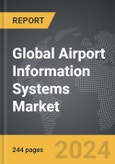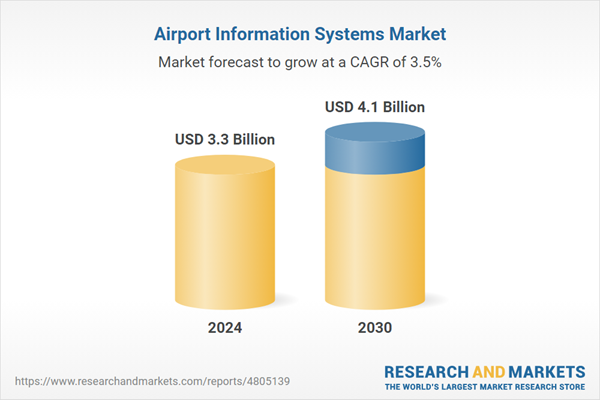Global Airport Information Systems Market - Key Trends and Drivers Summarized
What Are Airport Information Systems?
Airport Information Systems (AIS) encompass a broad range of technologies and solutions designed to manage and streamline the vast array of operations within an airport. These systems include flight information display systems (FIDS), baggage handling systems, passenger processing systems, resource management systems, and security systems, among others. The primary goal of AIS is to enhance efficiency, improve passenger experience, and ensure safety and security. FIDS, for example, provide real-time updates on flight schedules, gate assignments, and boarding times, crucial for both passengers and airport staff. Baggage handling systems ensure that luggage is accurately tracked and delivered to the correct destinations, reducing the risk of lost or delayed baggage. Passenger processing systems, including automated check-in kiosks and biometric verification, expedite the movement of passengers through check-in, security, and boarding procedures.How Do These Systems Enhance Airport Operations?
The integration of various Airport Information Systems significantly enhances the operational efficiency of airports. Resource management systems, for example, allocate gates, manage ground support equipment, and schedule staff shifts to ensure optimal use of resources and smooth operations. Advanced security systems employ technologies such as biometric screening, AI-driven surveillance, and automated threat detection to maintain high security levels while minimizing delays. Moreover, the implementation of AIS contributes to better coordination and communication among different stakeholders, including airlines, ground handlers, and airport authorities. This integration facilitates the sharing of critical information, leading to more informed decision-making and swift resolution of issues. Ultimately, these systems work together to create a seamless travel experience, reduce operational costs, and increase airport capacity and throughput.What Are the Key Components of AIS Infrastructure?
The infrastructure of Airport Information Systems is composed of several key components, each playing a critical role in the overall functionality of the airport. Data management and analytics platforms aggregate and analyze vast amounts of data generated by various AIS, providing actionable insights to airport management. Internet of Things (IoT) devices, including sensors and beacons, collect real-time data on passenger flow, environmental conditions, and equipment status, feeding this information into centralized systems for analysis and response. Communication networks, both wired and wireless, ensure robust and reliable data transmission across the airport. Cloud-based solutions offer scalable and flexible platforms for managing AIS, enabling airports to quickly adapt to changing demands and integrate new technologies. Additionally, cybersecurity measures are essential to protect sensitive information and ensure the integrity of AIS against cyber threats.What Is Driving the Growth in the AIS Market?
The growth in the Airport Information Systems market is driven by several factors, reflecting advancements in technology, evolving consumer behavior, and the increasing complexity of airport operations. One of the primary drivers is the rising adoption of automation and digitalization in airports, aiming to enhance operational efficiency and passenger experience. The surge in global air travel demand necessitates the expansion and modernization of airport infrastructure, thereby increasing the need for advanced AIS. Consumer expectations for a seamless and hassle-free travel experience are prompting airports to invest in state-of-the-art passenger processing and baggage handling systems. Additionally, the implementation of stringent security regulations requires sophisticated security systems capable of managing and processing vast amounts of data. The increasing availability and affordability of IoT devices and cloud computing solutions are enabling airports to adopt comprehensive AIS without significant upfront costs. Lastly, government initiatives and investments in smart airport projects are further propelling the growth of the AIS market, as airports seek to leverage cutting-edge technologies to stay competitive and meet the needs of modern travelers.Report Scope
The report analyzes the Airport Information Systems market, presented in terms of market value (USD). The analysis covers the key segments and geographic regions outlined below.- Segments: Function (Airport Operation Control Center (AOCC), Departure Control System (DCS)); End-Use (Passenger Systems, Non-Passenger Systems).
- Geographic Regions/Countries: World; United States; Canada; Japan; China; Europe (France; Germany; Italy; United Kingdom; Spain; Russia; and Rest of Europe); Asia-Pacific (Australia; India; South Korea; and Rest of Asia-Pacific); Latin America (Argentina; Brazil; Mexico; and Rest of Latin America); Middle East (Iran; Israel; Saudi Arabia; United Arab Emirates; and Rest of Middle East); and Africa.
Key Insights:
- Market Growth: Understand the significant growth trajectory of the Airport Operation Control Center (AOCC) segment, which is expected to reach US$2.7 Billion by 2030 with a CAGR of 3.4%. The Departure Control System (DCS) segment is also set to grow at 3.6% CAGR over the analysis period.
- Regional Analysis: Gain insights into the U.S. market, valued at $899.3 Million in 2024, and China, forecasted to grow at an impressive 5.8% CAGR to reach $827.2 Million by 2030. Discover growth trends in other key regions, including Japan, Canada, Germany, and the Asia-Pacific.
Why You Should Buy This Report:
- Detailed Market Analysis: Access a thorough analysis of the Global Airport Information Systems Market, covering all major geographic regions and market segments.
- Competitive Insights: Get an overview of the competitive landscape, including the market presence of major players across different geographies.
- Future Trends and Drivers: Understand the key trends and drivers shaping the future of the Global Airport Information Systems Market.
- Actionable Insights: Benefit from actionable insights that can help you identify new revenue opportunities and make strategic business decisions.
Key Questions Answered:
- How is the Global Airport Information Systems Market expected to evolve by 2030?
- What are the main drivers and restraints affecting the market?
- Which market segments will grow the most over the forecast period?
- How will market shares for different regions and segments change by 2030?
- Who are the leading players in the market, and what are their prospects?
Report Features:
- Comprehensive Market Data: Independent analysis of annual sales and market forecasts in US$ Million from 2024 to 2030.
- In-Depth Regional Analysis: Detailed insights into key markets, including the U.S., China, Japan, Canada, Europe, Asia-Pacific, Latin America, Middle East, and Africa.
- Company Profiles: Coverage of players such as Amadeus IT Group SA, Ikusi, Inform GmbH, Northrop Grumman Corporation, RESA Airport Data Systems and more.
- Complimentary Updates: Receive free report updates for one year to keep you informed of the latest market developments.
Some of the 41 companies featured in this Airport Information Systems market report include:
- Amadeus IT Group SA
- Ikusi
- Inform GmbH
- Northrop Grumman Corporation
- RESA Airport Data Systems
- Rockwell Collins, Inc.
- Siemens AG
- SITA
- Ultra Electronics Holdings PLC
This edition integrates the latest global trade and economic shifts into comprehensive market analysis. Key updates include:
- Tariff and Trade Impact: Insights into global tariff negotiations across 180+ countries, with analysis of supply chain turbulence, sourcing disruptions, and geographic realignment. Special focus on 2025 as a pivotal year for trade tensions, including updated perspectives on the Trump-era tariffs.
- Adjusted Forecasts and Analytics: Revised global and regional market forecasts through 2030, incorporating tariff effects, economic uncertainty, and structural changes in globalization. Includes historical analysis from 2015 to 2023.
- Strategic Market Dynamics: Evaluation of revised market prospects, regional outlooks, and key economic indicators such as population and urbanization trends.
- Innovation & Technology Trends: Latest developments in product and process innovation, emerging technologies, and key industry drivers shaping the competitive landscape.
- Competitive Intelligence: Updated global market share estimates for 2025, competitive positioning of major players (Strong/Active/Niche/Trivial), and refined focus on leading global brands and core players.
- Expert Insight & Commentary: Strategic analysis from economists, trade experts, and domain specialists to contextualize market shifts and identify emerging opportunities.
Table of Contents
Companies Mentioned (Partial List)
A selection of companies mentioned in this report includes, but is not limited to:
- Amadeus IT Group SA
- Ikusi
- Inform GmbH
- Northrop Grumman Corporation
- RESA Airport Data Systems
- Rockwell Collins, Inc.
- Siemens AG
- SITA
- Ultra Electronics Holdings PLC
Table Information
| Report Attribute | Details |
|---|---|
| No. of Pages | 244 |
| Published | December 2025 |
| Forecast Period | 2024 - 2030 |
| Estimated Market Value ( USD | $ 3.3 Billion |
| Forecasted Market Value ( USD | $ 4.1 Billion |
| Compound Annual Growth Rate | 3.5% |
| Regions Covered | Global |









